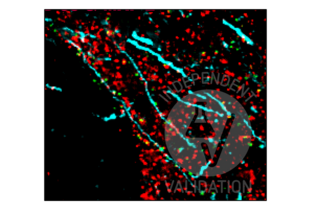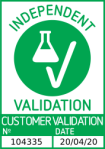SYN1 antibody (AA 362-511)
Quick Overview for SYN1 antibody (AA 362-511) (ABIN5542390)
Target
See all SYN1 AntibodiesReactivity
Host
Clonality
Conjugate
Application
Clone
-
-
Binding Specificity
- AA 362-511
-
Purpose
- SYN1 Antibody
-
Purification
- Purified antibody
-
Immunogen
- Purified recombinant fragment of human SYN1 (AA: 362-511) expressed in E. Coli.
-
Isotype
- IgG1
-
-
-
-
Application Notes
-
ELISA: 1/10000
FCM: 1/200 - 1/400
ICC: 1/200 - 1/1000
-
Restrictions
- For Research Use only
-
-
- by
- Akoya Biosciences
- No.
- #104335
- Date
- 04/20/2021
- Antigen
- SYN1
- Lot Number
- 151229
- Method validated
- Multiplex Immunohistochemistry
- Positive Control
FFPE normal human cortex
- Negative Control
Unlabeled control (FFPE normal human cortex)
- Notes
Passed. The anti-SYN1 antibody ABIN5542390 produces punctate labeling in synapse-rich regions of the human cortex. This pattern is consistent with expected SYN1 localization in synaptic contacts.
- Primary Antibody
- ABIN5542390
- Secondary Antibody
- Full Protocol
- Protocol details are described in the Akoya Biosciences CODEX® User Manual (see https://www.akoyabio.com/wp-content/uploads/2021/01/CODEX-User-Manual.pdf).
- Tissue preparation as outlined in the Akoya Biosciences CODEX® User Manual fresh-frozen tissue protocol.
- Conjugation of the anti-SYN1 antibody ABIN5542390 to an oligo barcode used to bind oligo-conjugated fluorophore AF488.
- Experimental Notes
No signal was detected in unlabeled specimens.
Specific staining of Cortactin was also observed with human FFPE cortical tissue sections with both citrate antigen retrieval and EDTA antigen retrieval.
Optimal staining and signal to noise ratios were obtained if tissue was pre-treated for autofluorescence removal (see https://www.akoyabio.com/wp-content/uploads/2020/07/Customer-Demonstrated-Protocol-Autofluorescence-Quenching-Mar2020.pdf).
Validation #104335 (Multiplex Immunohistochemistry)![Successfully validated 'Independent Validation' Badge]()
![Successfully validated 'Independent Validation' Badge]() Validation Images
Validation Images![FFPE normal human cortex tissue section labeled with anti-SYN1 antibody ABIN5542390 (blue; bound to fluorophore AF488) after EDTA antigen retrieval. MAP2 and SLC32A1 were labeled with anti-MAP2 antibody ABIN125739 (red; bound to fluorophore ATTO 500) and anti-SLC32A1 antibody ABIN2855225 (green; bound to fluorophore AF488).]() FFPE normal human cortex tissue section labeled with anti-SYN1 antibody ABIN5542390 (blue; bound to fluorophore AF488) after EDTA antigen retrieval. MAP2 and SLC32A1 were labeled with anti-MAP2 antibody ABIN125739 (red; bound to fluorophore ATTO 500) and anti-SLC32A1 antibody ABIN2855225 (green; bound to fluorophore AF488).
FFPE normal human cortex tissue section labeled with anti-SYN1 antibody ABIN5542390 (blue; bound to fluorophore AF488) after EDTA antigen retrieval. MAP2 and SLC32A1 were labeled with anti-MAP2 antibody ABIN125739 (red; bound to fluorophore ATTO 500) and anti-SLC32A1 antibody ABIN2855225 (green; bound to fluorophore AF488).
![FFPE normal human cortex tissue section labeled with anti-SYN1 antibody ABIN5542390 (red; bound to fluorophore AF488) after EDTA antigen retrieval. MAP2 and DLG4 were labeled with anti-MAP2 antibody ABIN125739 (cyan; bound to fluorophore ATTO 550) and anti-DLG4 antibody ABIN361694 (green; bound to fluorophore ATTO 550).]() FFPE normal human cortex tissue section labeled with anti-SYN1 antibody ABIN5542390 (red; bound to fluorophore AF488) after EDTA antigen retrieval. MAP2 and DLG4 were labeled with anti-MAP2 antibody ABIN125739 (cyan; bound to fluorophore ATTO 550) and anti-DLG4 antibody ABIN361694 (green; bound to fluorophore ATTO 550).
Full Methods
FFPE normal human cortex tissue section labeled with anti-SYN1 antibody ABIN5542390 (red; bound to fluorophore AF488) after EDTA antigen retrieval. MAP2 and DLG4 were labeled with anti-MAP2 antibody ABIN125739 (cyan; bound to fluorophore ATTO 550) and anti-DLG4 antibody ABIN361694 (green; bound to fluorophore ATTO 550).
Full Methods -
-
Format
- Liquid
-
Buffer
- Purified antibody in PBS with 0.05 % sodium azide.
-
Preservative
- Sodium azide
-
Precaution of Use
- This product contains Sodium azide: a POISONOUS AND HAZARDOUS SUBSTANCE which should be handled by trained staff only.
-
Storage
- 4 °C,-20 °C
-
Storage Comment
- Store at 4°C short term. Aliquot and store at -20°C long term. Avoid freeze/thaw cycles.
-
-
- SYN1 (Synapsin I (SYN1))
-
Alternative Name
- SYN1
-
Background
-
This gene is a member of the synapsin gene family. Synapsins encode neuronal phosphoproteins which associate with the cytoplasmic surface of synaptic vesicles. Family members are characterized by common protein domains, and they are implicated in synaptogenesis and the modulation of neurotransmitter release, suggesting a potential role in several neuropsychiatric diseases. This member of the synapsin family plays a role in regulation of axonogenesis and synaptogenesis. The protein encoded serves as a substrate for several different protein kinases and phosphorylation may function in the regulation of this protein in the nerve terminal. Mutations in this gene may be associated with X-linked disorders with primary neuronal degeneration such as Rett syndrome. Alternatively spliced transcript variants encoding different isoforms have been identified.
-
Molecular Weight
- 74.1 kDa
-
Gene ID
- 6853
-
UniProt
- P17600
Target
-



 (1 validation)
(1 validation)



